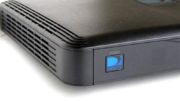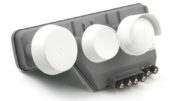Your satellite dish sits on the roof day after day, year after year. While I was told that a dish is designed to last 2-3 years, I’ve seen dishes that work perfectly for a decade or more. That’s not bad when you consider the sensitive electronics in them. While you have looked at that roof-mounted dish every year, have you ever stopped to wonder what it’s made of?
The answer mostly boils down to three words:
Powder-coated steel
Both the mount and the reflector (the big “dishy” part) are made of powder-coated steel. So is the hardware on the back that lets you adjust it, although the knobs are chrome-plated instead of powder-coated.
Powder-coating is a way of getting color onto metal that’s cleaner and more effective than traditional paint. It’s used in cars as well as many other metal parts because it’s durable. With powder coating, the entire metal piece is given a negative charge. Then, it’s passed through a spray of powder that holds a positive charge. The powder sticks to the metal as long as the charge is applied. By the way, this is more or less the same way that toner gets onto paper in a laser printer.
While the whole thing is still stuck together, it’s passed through an oven which bakes the powder into a firm coating that sticks to the metal. The result is harder to scratch than paint and lasts longer too. When it’s time to clean up, the electrical charges are turned off and the excess powder can be swept up, filtered and used again. Unlike paint, there’s no long-term residue or harmful chemicals.
Powder-coating is more resistant to weather and oxidation meaning that it’s perfect for things that will be outside. As long as you don’t scratch a dish hard enough to get through the powder, it won’t rust and that’s a good thing.
Why aren’t dishes made of aluminum?
Aluminum is used on antennas because it’s a great combination of low weight and really good conductivity. Remember that an antenna is reacting to electricity being sent to it from a broadcast transmitter, so conductivity is important. While aluminum isn’t as conductive as gold or copper, it’s cheaper and almost as good.
Most of a satellite dish doesn’t really receive the signal. The only part of a dish that actually receives the signal is the LNB, which is the part in the front hidden behind a white plastic horn. This LNB contains all the sensitive electronics to receive the signal, amplify it, and convert it into a form that can travel down a wire.
If it’s time to replace your dish
Satellite dishes are very durable but they do break sometimes. If you’re looking to fix reception issues with your satellite dish, call the experts at Solid Signal at 888-233-7563. They can recommend the best dish for you, whether it’s a direct replacement for what you have or an upgrade that can take you into the next decade and still be completely future-proof.





